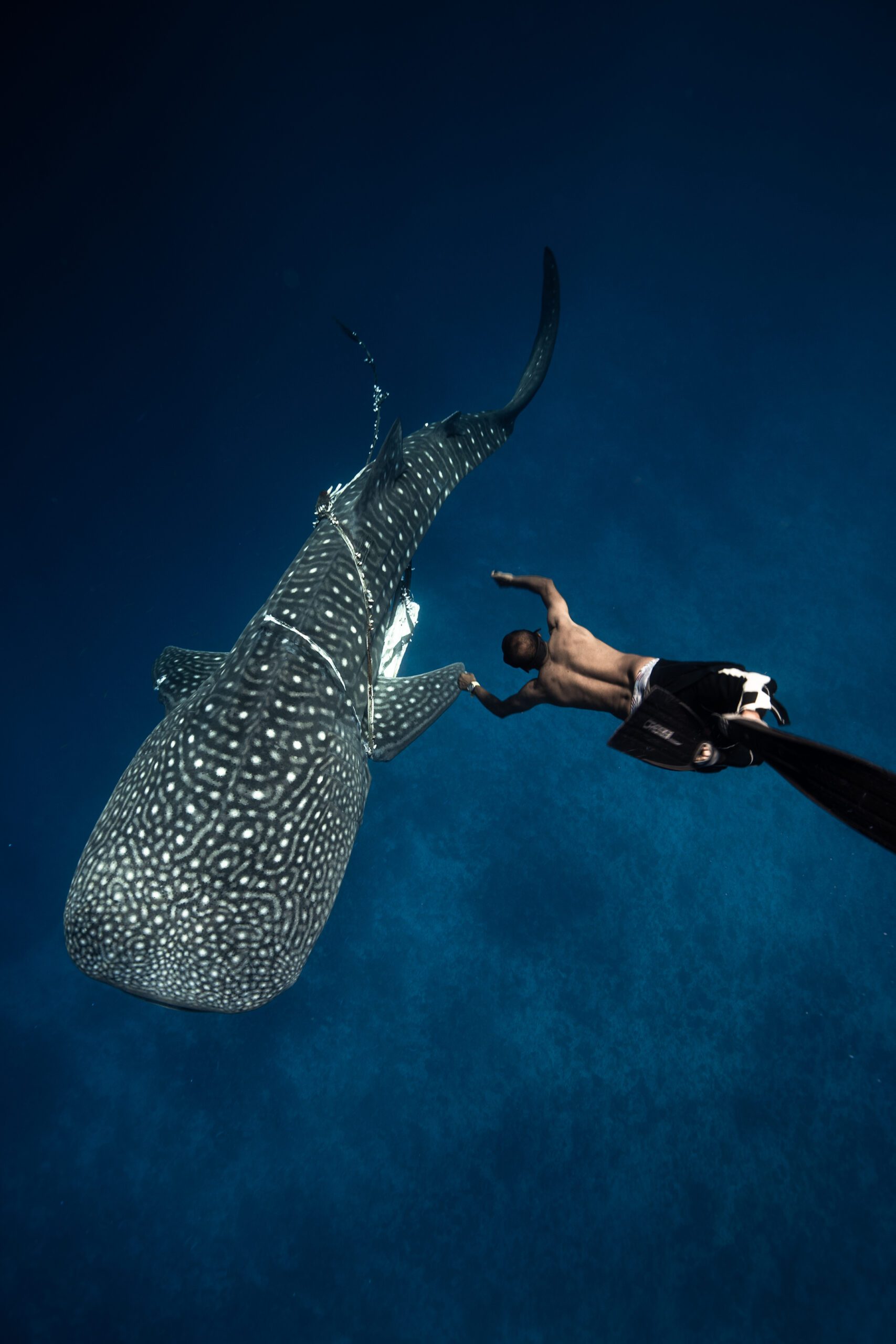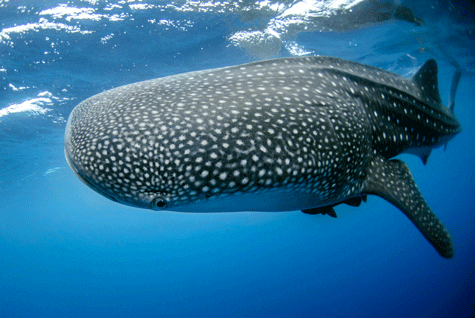
Throughout human history, myths are rooted as a fundamental part of human culture. Some have faith in unseen powers related to animals and plants. Although some people don’t believe these myths, they have a great impact on human life.
Maldives has a rich history and culture that is also touched by myths and folklore. In Maldives, fishermen still perform fanditha (traditional black magic) to drive away big predators or fish that they encounter or see on the surface of the ocean while fishing for some targeted species like tuna, believing that it is a bad omen. Some Maldivian folktales are also based on whale sharks. There is a folklore about a whale shark which gave protection for a man who fell into the open sea while his boat was journeying the high seas.
In the story, the man held his hand around the fin of the whale. The fish never dived deep down the sea after meeting the human. According to the myth, the man ate raw fish with the help of the whale. In the folklore, it was believed that many fishermen saw the whale and the man several times. The fish retreated when it saw a fishing vessel. In Mozambique, a tribe believes that one of their gods poured silver coins on the whale’s body to appreciate the beauty of the creature he witnessed during his visit to Earth. The tribe believed that this resulted in the appearance of white spots on the fish.
The whale shark is the world’s largest living fish. This fish is most commonly spotted in coastal areas where they feed. These are the places they gather or congregate. The whale sharks are divided into two different subpopulations—Atlantic and Indo-Pacific. According to studies, the majority of them live in the Indo-Pacific region. But the population has decreased 63%, and the Atlantic population has also decreased by more than 30% (12th Meeting of CoP12, whale shark, n.d.). The whale shark population has declined globally by more than 50% during the past three generations. The species has been listed as endangered globally on the IUCN Red List of Endangered Species.
Castro et al. (2007) estimated that the female population is around 119,000–238,000 whale sharks. Whale sharks can live from 70 to 100 years. They reach sexual maturity after 25 years. After this span of time, it reaches eight to nine meters. But there are reports that some people have seen whale sharks measuring up to 18 meters in length.
They are ovoviviparous.
Whale sharks were long thought to be oviparous. Which means, like many other fish, they lay eggs. A female whale shark can store sperm for many months. It can have babies at different stages of development. Dr. Gudger, a renowned expert on whale sharks, stated (Gudger, 1935) that “It is my judgment that the whale shark will be found to be viviparous—i.e., a live bearer. The young, when born, must be of good size, too large to be hatched from a shelled egg extruded into water. The just-born young must be at least three to five feet long—perhaps as much as eight to ten. Quien saba!”
Earlier there were theories concluding that the whale sharks are oviparous. Southwell’s observation (1912-13) was based on a specimen taken at Dutch Bay, west coast of Sri Lanka, in which he found “very ripe ovary, oviduct full of egg, 16 cases counted, same form as in dogfish.” However, based on Southwell’s observations, Bigelow and Schroeder (1948) suggested the possibility of the development stage of Rhiniodon being ovoviviparous. He changed his views on the same grounds Gudger (1952) concluded oviparity to be a possibility.
Size
The largest whale shark record is over 59 feet from the Gulf of Siam (Smith, 1925). However, actual measurements were not taken on this specimen. The actual measurement recorded from the Seychelles Islands by Wright (1870) measured 45 feet (Silas, n.d). And the smallest recorded was 3.15 m in Indian coastal waters. Shri Ali Manikfan, formerly of the Central Marine Fisheries Research Institute, from the Minicoy Island in the Lakshadweep Archipelago, said he has seen on at least three occasions whale sharks caught at Minicoy, but none of the specimens was longer than eight feet. Their occurrence is rare. According to some studies, individuals between four and nine meters are more likely to be encountered in Indian coastal waters. According to information from Ali Manikfan, early juvenile whale sharks may be found in oceanic waters.
Food
Whale shark feeding aggregations have been recorded in 20 countries, which include Australia, the Gulf of Mexico, Belize, the Gulf of California, Seychelles, and the Maldives. They feed on microscopic plankton and small fish that they suck into their mouth. Their mouth is around one and a half meters wide. They have a small throat—around the size of a drain pipe. Ram filtration and suction feeding are the two methods they use for feeding. Suction feeding allows whale sharks to feed on more mobile prey such as small fish, which they actively suck into their mouths. Whale sharks are believed to feed on suction filtering. This is because their gills are small. Shells of small Sepia and some small fishes (Gobiidid and Saurids) have been found in the stomach of one of the specimens harpooned in Batavia Bay, Indonesia. The whale shark has been noted to feed on tuna bait fish, such as anchovies and sardines (Gudger, 1915, 1918, 1935, 1941a, 1953).
Some studies have revealed that they are herbivorous. Wright (1868, 1870) found large masses of algae as stomach contents of the whale shark he examined in Seychelles. He concluded that the whale shark was herbivorous. In Indian coastal waters, Ms. Cann (1954) also carried out an examination of the stomachs of two specimens, and the observations show that marine algae could as well form an item of the food of the whale shark during its visits to the coastal waters. Researchers also conclude that the dietary habit may change according to age. It was also interesting to note the stomach of a female specimen taken from Dutch Bay, west coast of Sri Lanka, was empty (Southwell’s 1912-’13). From this he remarked that the whale shark is an omnivorous feeder and not a purely zooplankton feeder or herbivore (Silas, n.d.).
Weak eyesight
Whale sharks have very weak eyesight. They are able to see around three meters away. They are guided by their nostrils, which are very sensitive, to find prey. They can detect chemicals in the water produced by their planktonic prey. Whale sharks spend most of their time at a depth of 50 to 250 m. It is believed that they dive deeper to remove parasites. They ascend to the surface to control their body temperature and also to intake oxygen. We can notice that they are sluggish and weak.
Schooling behavior
Whale sharks have been observed to swim about in small schools. Thomas (1887) apparently was the first to observe a school of whale sharks with individuals from 25 to 40 feet long in association with other sharks in New Guinea waters. Weber (1902) noted several whale sharks among a school of sharks and rays in the Strait of Buton, between the islands of Buton and Muna, southeast of Celebes.
Association with other species
It is observed that whale sharks and the bonito have been schooling. They have also been seen alongside tuna schools. Whale sharks, along with tuna, could be seeking their food. Whale sharks associate with rays, suckerfish, or remoras. Small shoals of stromateid fish (young Stromateus cinereus) also swim below the whale. Stromateus fish swim below the whale shark, keeping a distance of around six feet. And Carangid fish (Caranx gymnostothoides) are also seen associated with the whale shark.
Underwater sound
According to researchers, the sounds produced by the whale sharks are mechanical. Whale sharks do not possess anatomical or biological structures to make sound. According to scientists, the sound whale sharks produce is associated with the snapping of their jaws. They lack sound-producing organs. Scientists believe that these sounds are perhaps incidental. The snapping of jaws can produce sounds of low frequency that can travel long distances. Their communication or the sound that they produce is not fully understood.
In Maldives
In Maldives these majestic fish can be seen throughout the year. When the wind blows from the northeast, whale sharks can be seen on the western side of the atolls. That is from December to April. The abundance of plankton is a factor for the visibility. Therefore, the congregation happens downwind. South Ari Atoll is the most famous area for whale sharks in the Maldives. They can be found around the eastern side of Dhigurah Island during the southwest monsoon. It varies according to monsoon wind seasons.
Two groupings are noted in the Maldives: December to March and May to October. In central atolls the situation is the same. But from central atolls, the situation is different. In Haa Alif Atoll, the most northern atoll, the whale sharks are seen year-round. According to experts, the best time to see these beautiful creatures in Maldives is in May, November and December.




